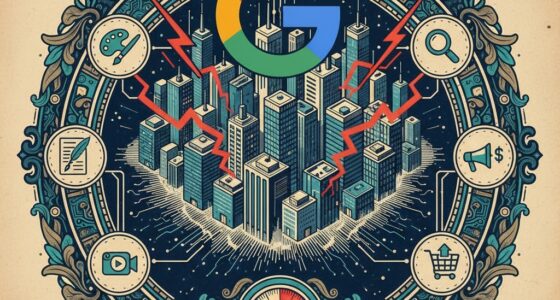Reimagining education is your key to preparing for AI-driven job disruptions. By embracing AI literacy, updating curricula, and fostering skills like creativity and critical thinking, you can help learners stay adaptable. Governments and schools are shaping policies and professional development to support this essential shift. Collaboration between industry and education creates tools for better instruction and future readiness. If you want to discover more ways to turn AI challenges into opportunities, keep exploring this crucial topic.
Key Takeaways
- Incorporate AI literacy and digital skills into curricula to prepare students for AI-driven job markets.
- Emphasize human skills like creativity and critical thinking to complement AI automation.
- Revamp teacher training and industry partnerships to effectively integrate AI tools in education.
- Foster lifelong learning and adaptability to help workers transition amidst AI-induced job shifts.
- Promote ethical and transparent AI policies in schools to ensure equitable and future-ready education systems.

Reimagining Education
As artificial intelligence becomes an integral part of education, it’s transforming how we learn and teach in ways never imagined before. You’re now part of a system where AI is embedded into everyday learning, making education more personalized and accessible. By 2025, the global market for AI in education has already reached $7.57 billion and is expected to soar to $112.30 billion by 2034. This rapid growth reflects how widely AI is adopted, with 86% of students worldwide using AI tools to aid their studies. Your learning experience is increasingly shaped by AI-driven platforms that explain concepts, summarize texts, or generate research ideas, making education more engaging and efficient. AI adoption in education has rapidly transitioned from experimental to essential within just a year, prompting institutions to rethink traditional teaching methods.
AI transforms education, making learning personalized, accessible, and more efficient worldwide.
This shift isn’t just about tools; it’s prompting a fundamental overhaul of curricula. Schools are emphasizing STEM education to prepare you for future AI-driven careers. New curricula focus heavily on AI literacy and digital fluency, ensuring you’re equipped not just to use technology but to understand its workings. As the job market evolves, your education emphasizes human skills like creativity and critical thinking—areas where AI still struggles to replicate human ingenuity. Globally, two-thirds of countries now offer or plan to introduce K–12 computer science programs, ensuring future generations are tech-savvy from an early age.
Educational policies are adapting to this new landscape as well. In the U.S., the Department of Education has issued guidelines emphasizing responsible AI use, transparency, and ethical considerations. Governments worldwide are developing frameworks to regulate AI in schools, seeking your input through public comment periods. These measures aim to guarantee AI’s integration benefits students while safeguarding ethical standards. Additionally, understanding the tax implications of Gold IRAs can be important for securing your financial future amidst these technological shifts, as economic stability plays a role in supporting your education investments.
Teacher training is also evolving. Educators are receiving professional development to understand AI pedagogy, but many face challenges integrating new tools into their classrooms. Industry partnerships are helping develop relevant curricula, and collaborative AI tools are supporting teachers’ efforts. Your teachers are encouraged to keep learning themselves, ensuring they stay updated on AI developments that can enhance your education.
In higher education, AI adoption is accelerating. A significant majority of students, especially in the UK, are using AI daily—often for explaining concepts or generating content. This trend demonstrates how AI tools are already reshaping your academic work, making it crucial to adapt your skills. Reimagining education is key to turning AI’s disruptions into opportunities, ensuring you’re prepared for the evolving job market and the future of work.
Frequently Asked Questions
How Can Curricula Be Adapted for Rapidly Changing Ai-Driven Job Markets?
You can adapt curricula by integrating AI literacy across subjects, emphasizing flexibility and soft skills, and promoting project-based learning to mimic real-world AI applications. Encourage continuous learning pathways, partner with industry for practical experience, and incorporate emerging technologies like VR and AR for hands-on training. Focus on interdisciplinary education and soft skills to prepare students for the dynamic, AI-driven job market, ensuring they stay adaptable and competitive.
What Role Do Educators Play in Fostering AI Resilience Among Students?
You play a vital role in fostering AI resilience among students by integrating AI literacy into your teaching. You help students understand AI’s benefits and challenges, encouraging critical thinking and adaptability. Using AI tools yourself, you personalize learning and track progress, providing targeted support. You also motivate students to view AI as an opportunity, not a threat, empowering them to develop skills that will keep them competitive in a rapidly evolving job market.
How Can Technology Enhance Personalized Learning Experiences Effectively?
Technology transforms teaching into tailored, try-it-today tutorials. By harnessing AI algorithms, you can create customized curricula that adapt to each student’s unique learning style and speed. Interactive tools like virtual reality, gamification, and microlearning modules make lessons more engaging and effective. You empower students to explore, experiment, and excel at their own pace, turning traditional education into a dynamic, data-driven journey that sparks curiosity and boosts outcomes.
What Are the Risks of Over-Reliance on Digital Education Tools?
You risk losing the human touch essential for meaningful learning when over-relying on digital tools. It can deepen inequalities if some students lack access, and data breaches threaten privacy. Additionally, malfunctioning AI systems may hinder progress, while cyber threats like ransomware and phishing increase your institution’s vulnerability. Without balanced use and proper safeguards, digital education might create more problems than it solves, impacting student outcomes and overall security.
How Can Education Systems Ensure Equitable Access to Reimagined Learning?
You can guarantee equitable access by investing in reliable internet and devices for low-income students, partnering with community organizations, and advocating for policies that support digital inclusion. Focus on training teachers to use innovative tools effectively and develop curricula that address diverse needs. Additionally, prioritize funding and infrastructure improvements to bridge gaps, making sure all students can benefit from reimagined learning environments and opportunities, regardless of socioeconomic background.
Conclusion
By reimagining education, you can prepare yourself for the AI-driven job market. Think of a student who learns coding and critical thinking early on, turning potential job shocks into opportunities. For instance, imagine a future where schools emphasize creativity and adaptability—ensuring you’re not left behind as AI transforms industries. Embrace this change now; your proactive approach can turn challenges into stepping stones for a resilient, future-proof career.










